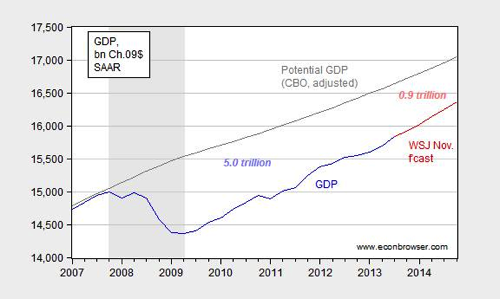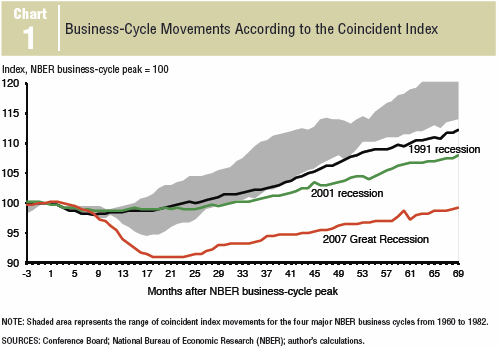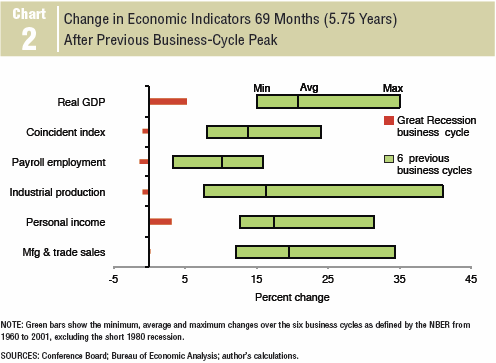Things to Read on the Afternoon of December 9, 2013
Must-Reads:
-
Mark Thoma: sends us to John Cassidy: By George, Britain’s Austerity Experiment Didn’t Work! :”George Osborne, the patron saint of austerity enthusiasts on both sides of the Atlantic, was in the House of Commons on Thursday, reveling in the fact that the U.K.’s economy is finally growing again…. For Britons who have been laboring through more than five years of recession, or near recession, that is welcome news…. It’s a clever political line… it appears to be having an impact… caught by surprise most forecasters…. But from an economic perspective, Osborne’s argument is hogwash. His effort to cure the patient by subjecting it to the equivalent of leeching—big cuts in government spending and higher taxes—a return to pre-Keynesian policies watched closely the world over, failed abysmally…. It produced a dearth of public-sector and private-sector investment that will hobble Britain for years to come. It even failed to meet its own targets of drastically reducing the budget deficit and bringing down Britain’s over-all debt burden…. The problem… is that the ‘hard work’ hasn’t paid off. After three and a half years of austerity, the outlook for the government’s finances doesn’t look any better than it did when Osborne entered office. In fact, it looks worse…”
-
Paul Krugman: Robert Gordon vs. the Androids: I think I have a new way to explain why my gut feeling is that Bob [Gordon], while making a persuasive case (pdf), is probably wrong. Bob’s key point… is that the digital revolution really just doesn’t match up to the major innovations of the Second Industrial Revolution of the late 19th century…. But… suppose that we learned to build true androids… that would be transformative… end diminishing returns to capital accumulation… raising GDP per capita would simply be a matter of multiplying the androids. So how are things going on the android front? A decade ago I would have said “very badly”…. But something has happened—things that were widely regarded as jokes not long ago, like speech recognition, machine translation, self-driving cars, and so on, have suddenly become more-or-less working reality…. They’re using big data and correlations and so on to implement algorithms–mindless algorithms, you might say. But if they can take people’s place, does it matter?
“The anti-Gordon case, then, would be that something like my android revolution is underway. If you buy that case, you can become a technological optimist…. You might also be a pessimist in the sense that you wonder what happens to wages once androids can do most human work. Also, Skynet will kill us all. But that, anyway, is where I would place the issue.”
-
Noah Smith: Noahpinion: Seven principles for arguing with economists: “1: Credentials are not an argument…. Suggested Retort: Loud, barking laughter. 2: ‘All theories are wrong’ is false…. Suggested Retort: Empty an entire can of Silly String onto anyone who says this…. 3: ‘We have theories for that’ is not good enough…. Suggested Retort: ‘Then how come no one was paying attention to those theories before Phenomenon X emerged and slapped us upside the head?’…. 4: Argument by accounting identity almost never works…. Suggested Retort: ‘If my theory violates an accounting identity, wouldn’t people have noticed that before? Wouldn’t this fact be common knowledge?’… 5: The Efficient Markets Hypothesis does not automatically render all models useless…. Suggested Retort: ‘By your logic, astrophysics can never predict when an asteroid is going to hit the Earth.’… 6: Models that only fit one piece of the data are not very good models…. Suggested Retort: ‘Nope!’… 7: The message is not the messenger…. Suggested Retort: ‘Well, now it’s me making the argument! So what are you going to say about me?’…”
Should-Reads:
-
Dave Reifschneider, William L. Wascher, and David Wilcox: Aggregate Supply in the United States: Recent Developments and Implications for the Conduct of Monetary Policy: “The recent financial crisis and ensuing recession appear to have put the productive capacity of the economy on a lower and shallower trajectory than the one that seemed to be in place prior to 2007. Using a version of an unobserved components model introduced by Fleischman and Roberts (2011), we estimate that potential GDP is currently about 7 percent below the trajectory it appeared to be on prior to 2007. We also examine the recent performance of the labor market. While the available indicators are still inconclusive, some indicators suggest that hysteresis should be a more present concern now than it has been during previous periods of economic recovery in the United States. We go on to argue that a significant portion of the recent damage to the supply side of the economy plausibly was endogenous to the weakness in aggregate demand—contrary to the conventional view that policymakers must simply accommodate themselves to aggregate supply conditions. Endogeneity of supply with respect to demand provides a strong motivation for a vigorous policy response to a weakening in aggregate demand, and we present optimal-control simulations showing how monetary policy might respond to such endogeneity in the absence of other considerations. We then discuss how other considerations— such as increased risks of financial instability or inflation instability—could cause policymakers to exercise restraint in their response to cyclical weakness.”
-
Andrea Frazzini, David Kabiller, and Lasse Heje Pedersen: Buffett’s Alpha: “Berkshire Hathaway has realized a Sharpe ratio of 0.76, higher than any other stock or mutual fund with a history of more than 30 years, and Berkshire has a significant alpha to traditional risk factors. However, we find that the alpha becomes insignificant when controlling for exposures to Betting-Against-Beta and Quality-Minus-Junk factors. Further, we estimate that Buffett’s leverage is about 1.6-to-1 on average. Buffett’s returns appear to be neither luck nor magic, but, rather, reward for the use of leverage combined with a focus on cheap, safe, quality stocks. Decomposing Berkshires’ portfolio into ownership in publicly traded stocks versus wholly-owned private companies, we find that the former performs the best, suggesting that Buffett’s returns are more due to stock selection than to his effect on management. These results have broad implications for market efficiency and the implementability of academic factors.”
-
 Menzie Chinn: Econbrowser: The Output Gap: Cumulative Losses, 2013Q3: “The number in light blue italics is the cumulative loss in Chained 2009$ from 2007Q4 to 2013Q3… pink blue italics is the cumulative loss incurred from 2013Q4 through 2014Q4, assuming the WSJ mean forecast holds…. Could we do more to close the gap? I think so–see here; and also here, regarding extending emergency unemployment benefits.”
Menzie Chinn: Econbrowser: The Output Gap: Cumulative Losses, 2013Q3: “The number in light blue italics is the cumulative loss in Chained 2009$ from 2007Q4 to 2013Q3… pink blue italics is the cumulative loss incurred from 2013Q4 through 2014Q4, assuming the WSJ mean forecast holds…. Could we do more to close the gap? I think so–see here; and also here, regarding extending emergency unemployment benefits.” -
Robert Shiller: Speculative Asset Prices
-
Mark Thoma: Economist’s View: ‘The Long Slog: Economic Growth Following the Great Recession’:

 “Speaking of the Dallas Fed, here are two figures from a report documenting how slow this recovery has been relative to the recovery from past recessions…”
“Speaking of the Dallas Fed, here are two figures from a report documenting how slow this recovery has been relative to the recovery from past recessions…”
Should Be Aware of:
-
Noah Smith: On Mike Elsby and the Decline in the Labor Share of Income : “There are basically three competing stories…. 1. Robots. Technology has made it cheap to replace humans with automation…. 2. Unions. The relentless decline of organized labor in rich countries has robbed workers of their bargaining power…. 3. China/India… a huge, relatively well-educated labor force to be suddenly dumped onto world markets. A glut of labor on the market means the return to labor goes down and the return to capital goes up. Mike Elsby and his coauthors find support mostly for story #3…. This is an important piece of research…. Stories about the Rise of the Robots are scary and seductive, but if Elsby is right, then this is more of a concern for the future than the past. And the decline of unions is sad… but… a symptom… rather than a cause…”
-
Michael Pettis: The politics of adjustment: “China has probably exhausted the growth model that had once served it so well. It now suffers from many of the internal imbalances that were the near-automatic and easily predictable consequences of the policies… policymakers in Beijing are very aware of the urgent need to adopt a new set of policies…. China is not the first country to have experienced a long period of miraculous growth…. The most difficult part of growth miracles has not been the growth miracle itself but rather the subsequent adjustment. Consider… the United States in the 1920s, Germany in the 1930s, the Soviet Union from the late 1940s to the early 1960s, Brazil from the late 1950s to the late 1970s, Japan in the 1980s, and many others…. In some cases… the adjustment was brutally difficult but the institutions that evolved during the adjustment period laid the groundwork for many more years of growth and stability…. In other cases… the adjustment period was long and protracted… unable to develop the right set of institutional reforms… collapsed into the kind of chaos from which it is still struggling to emerge.”
-
Amitabh Chandra, Jonathan Holmes, and Jonathan Skinner: Is This Time Different? The Slowdown in Healthcare Spending: “Why have health care costs moderated in the last decade? Some have suggested the Great Recession alone was the cause, but health expenditure growth in the depths of the recession was nearly identical to growth prior to the recession. Nor can the Affordable Care Act (ACA) can take credit, since the slowdown began prior to its implementation. Instead, we identify three primary causes of the slowdown: the rise in high-deductible insurance plans, state-level efforts to control Medicaid costs, and a general slowdown in the diffusion of new technology, particularly in the Medicare population. A more difficult question is: Will this slowdown continue? Here we are more pessimistic, and not entirely because a similar (and temporary) slowdown occurred in the early 1990s. The primary determinant of long-term growth is the continued development of expensive technology, and there is little evidence of a permanent slowdown in the technology pipeline. Proton beam accelerators are on target to double between 2010 and 2014, while the market for heart-assist devices (costing more than $300,000) is projected to grow rapidly. Accountable care organizations (ACOs) and emboldened insurance companies may yet stifle health care cost growth, but our best estimate over the next two decades is that health care costs will grow at GDP plus 1.2 percent; lower than previous estimates but still on track to cause serious fiscal pain for taxpayers and workers who bear the costs of higher premiums.”
Barack Obama: Economic Mobility | Perry Mehrling: MIT and Money | Steve Beshear sees p: Promise for Democrats in healthcare law | David Dobbs: Die, selfish gene, die: The selfish gene is one of the most successful science metaphors ever invented. Unfortunately, it’s wrong | Ezra Klein: Obamacare’s real promise: if you lose your health-care plan, you can get a new one | Jose Andres: Immigrants, like me, want to succeed. Congress should let them | J. W. Mason: The Slack Wire: The Interest Rate, the Interest Rate, and Secular Stagnation | Rachel Goldfarb: The Sky Isn’t Falling From Minimum Wage Hikes | Bryce Covert: Extending Long-Term Unemployment Benefits Would Save 240,000 Jobs |
